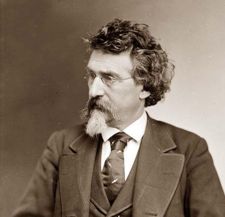Mathew Brady: Documenting America's Civil War  Mathew Brady is one of the most famous war photographers in the world. He was so influential that he’s credited with the birth of the photojournalism. Today, his photographs are considered a national treasure as they preserve one of the most difficult times in United States history, the Civil War. Brady’s photographs gave the world faces to put to the suffering and war of that time period. Mathew Brady is one of the most famous war photographers in the world. He was so influential that he’s credited with the birth of the photojournalism. Today, his photographs are considered a national treasure as they preserve one of the most difficult times in United States history, the Civil War. Brady’s photographs gave the world faces to put to the suffering and war of that time period.
Mathew Brady was born on January 15, 1896 in Warren County, New York to Irish immigrant parents. At 16, he moved to New York City. By 1841, he was working under daguerreotypist Samuel F.B. Morse. Brady managed to open his own photography studio in New York in 1844, where he displayed images of famous Americans. These early daguerreotypes won him many awards and by 1849, he opened a studio in Washington DC as well. In D.C. Brady met his wife, Juliette Handy. Brady’s portraits earned him much acclaim from his peers and he was settling into a comfortable life when the Civil War broke out. Brady understood the importance of preserving history and used his knowledge of photography to capture history in the making during the American Civil War. Despite advice from friends and family, Brady transported his studio right out onto the battlefields. His images gave the country a glimpse into the true nature of war, documenting the hardships the men endured, the devastation left behind, and the bravery of the men who died in battle. To make sure that he was able to fully capture the essence of the Civil War, Brady hired over 20 men to go to battlefields across the country, they are known as Brady's Men. Consequently, some of the images that are credited to Brady may not have actually been his photograph, but was photographed by one of Brady's Men. In October of 1862, he showcased his life’s work, an exhibition of photographs from the Battle of Antietam. The gallery was titled “The Dead at Antietam,” and consisted of mostly images of corpses and company portraits in the field. Before this, many people had no real concept of war and all its horrors. Brady’s determination to document the war through images spawned a movement to document life with the same level of realism, leading to photojournalism. In fact, many journalists today do exactly what he did, heading into war zones to ensure that its true nature never gets forgotten. After the American Civil War, Brady’s popularity waned. The government chose not to purchase his photos, and he was forced to file for bankruptcy. Brady had counted on the fact that the government would have bought his photos to ensure that history was preserved, so he amassed many debts to make sure they were taken properly and spared no expense in pursuit of his photography. Brady suffered severe from depression when he became blind and lost his wife, a tragic ending for the historic photographer. In 1896, he was in a streetcar accident that eventually cost him his life. He died on January 15, 1896, at the age of 73. Resources: -
Brady Portraits: An archive of Brady’s portraits taken during the Civil War. -
Biography: Discuses Brady’s early life and his importance to the Civil War. -
Brady's Life: An account of his entire life as well as some important influences. -
Brady Photographs: Government archive of his photos of the Union commanders and presidents as well as other aspects of the Civil War like the Confederacy and troops. -
Photos and Biography: Provides information about his life as well as a biography. -
Brady Intro: Highlights his role in the war. -
Today in History: Provides information about Brady and the day he took Lincoln’s portrait. -
War Photographers: Explains Brady’s importance as a war photographer. -
Photography at Antietam: Displays one of Brady’s photos and explains its circumstances. -
Brief History: A discussion of Brady’s life.
This article was written by Mike Haldas, co-founder and managing partner of CCTV Camera Pros. If you found it useful, please share it.
|









 Mathew Brady is one of the most famous war photographers in the world. He was so influential that he’s credited with the birth of the photojournalism. Today, his photographs are considered a national treasure as they preserve one of the most difficult times in United States history, the Civil War. Brady’s photographs gave the world faces to put to the suffering and war of that time period.
Mathew Brady is one of the most famous war photographers in the world. He was so influential that he’s credited with the birth of the photojournalism. Today, his photographs are considered a national treasure as they preserve one of the most difficult times in United States history, the Civil War. Brady’s photographs gave the world faces to put to the suffering and war of that time period.
